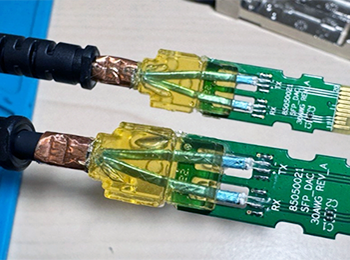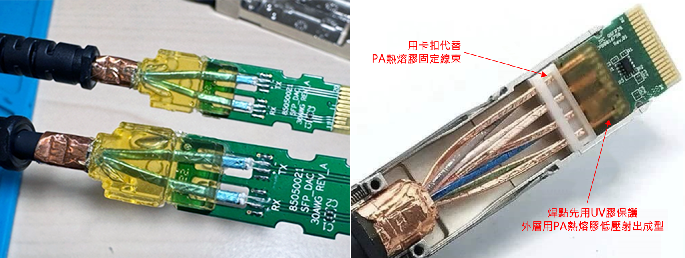Boost High-Speed Cable Reliability: UV Adhesive & Low-Pressure Polyamide for Solder Joints
2025-03-20
|
Table of Contents: |

Background: High-Speed Transmission in Data Centers
In today’s era of high-speed interconnects and data transmission, data centers and AI/GPU servers demand cables with superior reliability. The right adhesive materials not only extend service life but also safeguard signal integrity and mechanical stability throughout manufacturing and operation.
Cable Types: Internal vs. External
External cables (outside the chassis) connect servers, switches, and data center equipment—for example AOC, DAC, ACC/AEC, transceivers, switch power cords, and fiber jumpers.
Internal cables (inside the chassis) link high-speed signals and power within servers, storage, and AI/GPU modules, including MCIO (PCIe Gen5), Oculink/Thinline/GenZ/EDSFF, Multi-Trak, power cables/busbar/liquid-cooling connectors, and harnesses such as SATA, MiniSAS, riser, and leakage sensor cables.
Roles & Applications: Low-Pressure Polyamide Hot-Melt & UV Adhesive
Polyamide Hot-Melt (Low-Pressure Injection)
Used to form-lock and fix cable harnesses away from solder joints. Key benefits include high toughness and abrasion resistance, a low dielectric constant to reduce high-speed loss, strong heat and moisture resistance (e.g., 85 °C/85%RH), and flame retardancy compliant with RoHS/REACH—ideal for robust harness fixation and durability.
UV Adhesive (Solder Joints Protection)
Used to protect solder joints with minimal interference. It cures rapidly under UV light for automated, high-throughput lines, delivers high bond strength (≈17–19 MPa), features very low dielectric constant/loss for stable impedance matching, and shows low water absorption and good formability for high-temperature/high-humidity operation—common in fiber fixation and solder-joint protection.
Adhesive Strategies for Internal/External Cables

External Cables
Use PA (polyamide) hot melt to secure harness structures and UV adhesive to stabilize fiber/copper terminations; add a metal housing when additional physical protection is required. Single-material options are also viable: PA-only for harness overmolding and external protection, or UV-only for precise solder-joint encapsulation.

Internal Cables
In tight, vibration-prone spaces, use UV adhesive to seal and protect solder joints while polyamide hot melt forms molded structural protection. Options include UV + traditional housing + PA backfill for sealing and damping, UV + direct-injection PA outer shell for a simplified process, or a three-layer package (UV → PA fill → plastic outer shell) for enhanced stability.
Why Choose UV Adhesive & PA Hot-Melt?
-
Maintain signal integrity: low-k insulation lowers high-speed data loss.
-
Improve mechanical reliability: robust fixation reduces vibration and connector shift
-
Extend service life: moisture/dust/oxidation protection for long duty cycles.
-
Fit automated manufacturing: UV fast-curing and PA low-pressure molding align with smart production lines.
FAQ
Q1. Can PA and UV adhesives replace traditional materials?
A. Yes. Their dielectric and mechanical performance is better suited to high-frequency, high-speed applications than conventional hot-melt and silicone materials.
Q2. Do UV adhesives affect transmission quality?
A. Qualified UV adhesives cure to a low and stable dielectric constant and do not interfere with optical or copper-cable signals.
Q3. Will low-pressure molding thermally damage conductors?
A. No. Its molding temperature is lower than conventional injection processes, protecting fine conductors and sensitive components.